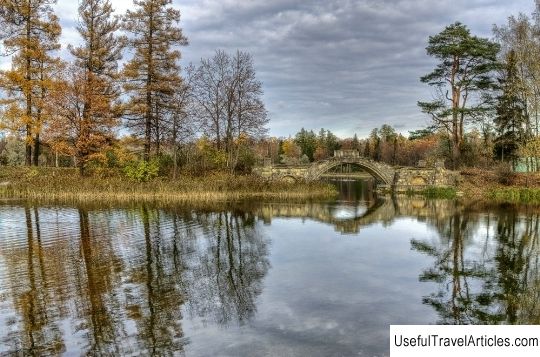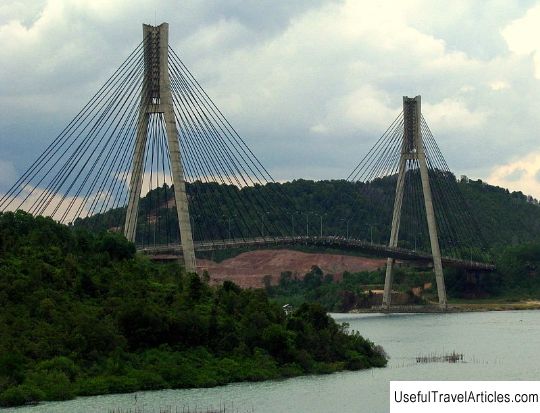Humpbacked bridge in the Palace Park description and photos - Russia - Leningrad region: Gatchina
Rating: 8,4/10 (2940 votes) Humpbacked bridge in the Palace Park description and photos - Russia - Leningrad region: Gatchina. Detailed information about the attraction. Description, photos and a map showing the nearest significant objects. Photo and descriptionThe humpback bridge is one of the most expressive symbols of the Gatchina park. The humpback bridge connects the island with the Eagle Pavilion and the island with the Terrace-Pier, it was built in 1800-1801. designed by A.D. Zakharov and by its artistic and constructive characteristics it is one of the best examples of high classicism park bridges. Previously, the bridge was called the "Bridge between the islands". This name was due to the fact that it was the only bridge in the Palace Park, which connected the two islands, other bridges connected the islands with the continent. The humpback bridge is located at the site of the widest flood of the White Lake and, as it were, connects everything together structures that are located along the perimeter of the lake, in addition, with its help, a smooth architectural transition is created to the Terrace-pier from the Eagle Pavilion. This location of the Humpbacked Bridge makes it an excellent observation platform. Andreyan Dmitrievich Zakharov managed to solve this architectural structure with an extraordinary stately simplicity, where every detail is subordinated to the general integrity. Working on the project of the bridge, from the rich arsenal of expressive means of architecture, Zakharov chose those that most fully and eloquently merge the artificial structure with the natural landscape of the park. All this was reflected in the constructive and compositional solution of the bridge, which is thrown over a channel with a width of about 25 m. The humpback bridge is made up of three main parts: two powerful coastal abutments and a steep arched span, which has a width of 9 m and a height of more than 3 m. The abutments create a feeling of solidity and monumentality, which is emphasized by the interpretation of their foundations, made of large stone blocks, laid in two rows. Sloping walls rise above the abutments, made up of five rows of masonry. The connection between the bridge and the islands is made in the form of stepped buttresses. In the middle part of each of the abutments, there is a hemispherical niche with a large keystone and a highly profiled archivolt. Niches introduce an additional dynamic motive into the arched support and emphasize the solidity of the foundations. The relief rectilinear cornice limits the trapezoidal foundations and the arch of the span. Above the cornice is a balustrade, which consists of six links above the bridge span and two above the abutments. A solid stone parapet with side braces matches the keystone of the balustrade span. Similar " weighting " the highest point of the arch of the bridge emphasizes the central part of the composition, and also continues the motive of the strength of the connecting link of the road raised above the water. The humpback bridge serves not only as a transition, but is also an open pavilion-belvedere, since it is located in an ideal the vantage point, moreover, is built in such a way as to provide a beautiful view from it. Each part of the bridge is designed as a view terrace. On the wide platforms of the abutments, stone benches with volute-shaped legs, enclosed by U-shaped bends of the balustrade, are placed. From the platforms there are stairs made of the Pudost slab, which converge on the upper terrace. Before the gaze of everyone climbing the bridge, several landscape paintings replace each other. The bridge-pavilion was intended for a long time and contemplation of the opening panoramic views, for enjoying the beauty of the surrounding nature. This was completely in the spirit of the romantic parks of the time. The importance of the Humpbacked Bridge in the compositional solution of the Palace Park and its monumental appearance, full of grandeur, led the architect to think about giving the bridge a more triumphant character. In 1801, an estimate was drawn up, according to which four bas-reliefs and Paul's monogram were to be made to decorate the bridge. During the Great Patriotic War, the Humpback Bridge was damaged, the benches and the balustrade were destroyed. During the retreat of the invading forces from Gatchina, it was planned to blow up the bridge, since after the liberation of Gatchina, mines for explosives were found in the abutments of the bridge. In 1969 and in the 1980s. the bridge was completely restored. Now it is in a dilapidated state.         We also recommend reading Museum of Science and Industry (MOSI) description and photos - Great Britain: Manchester Topic: Humpbacked bridge in the Palace Park description and photos - Russia - Leningrad region: Gatchina. |





